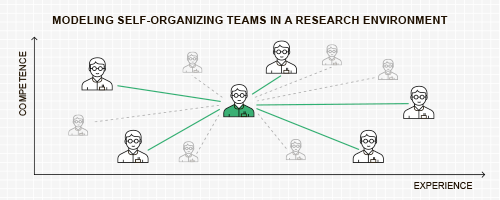Graphical abstract

|
ISSN 2587-814X (print), Russian version: ISSN 1998-0663 (print), |
Tamara Voznesenskaya1, Fedor Krasnov2, Rostislav Yavorsky1, Polina Chesnokova 3Modeling self-organizing teams in a research environment
2019.
No. 2 Vol.13.
P. 7–17
[issue contents]
This paper presents the results of studies aimed at analyzing the effectiveness of a research center. The study focuses on the process of self-organization of project teams (groups of co-authors) for project implementation (writing a scientific article). The initiative to create a team comes from one of its members. The paper describes a formal model, based on a competence approach, which considers the types of tasks to be solved and the necessary skills of the staff. The paper also presents the results of simulation in the AnyLogic environment and problems for further research. Graphical abstract 
Citation:
Voznesenskaya T.V., Krasnov F.V., Yavorsky R.E., Chesnokova P.V. (2019) Modeling self-organizing teams in a research environment. Business Informatics, vol. 13, no 2, pp. 7–17. DOI: 10.17323/1998-0663.2019.2.7.17 |

|
|